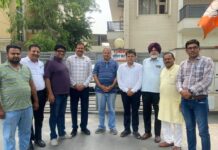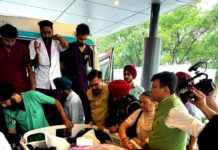World Parkinson’s Day
Innovative Approaches to Managing Parkinson’s Disease: Neurologists Highlight Role of Genetics, Diet and Advanced Therapies
— Parkinson’s disease is a neuro-degenerative disorder that causes tremors, rigidity, slowed movement, sleep disturbances and depression —
Chandigarh, April 11, 2025: Leading neurologists from Fortis Hospital, Mohali have advocated for a holistic and personalized approach to managing Parkinson’s disease, citing promising developments in genetics, nutrition, and advanced surgical treatments. They also emphasized how genetic testing, millet-based diets, and interventions such as Deep Brain Stimulation (DBS) are transforming patient care and symptom management.
During a press conference on World Parkinson’s Day, the team of doctors including Dr Sudesh Prabhakar, Director of Neurology; Dr Anupam Jindal, Additional Director, Neurosurgery; Dr Nishit Sawal, Senior Consultant, Neurology; and Dr Ravneet Kaur, Associate Consultant, Department of Medical Genetics, deliberated on the causes, symptoms and treatment modalities of Parkinson’s Disease.
Briefing the media, Dr Sudesh Prabhakar, said, “Though the disease is most commonly diagnosed in people above 60 years of age, it can also affect the younger population. Symptoms primarily comprise tremors, rigidity, slowed movement, problems in writing and communication; while the non-motor symptoms include sleep disturbances and depression. Some symptoms might also be associated with severe constipation, one of the initial symptoms of Parkinson’s disease.”
Highlighting the importance of liquid L-dopa formations and millet-based diets in managing Parkinson’s disease, Dr Nishit Sawal, said, “The absorption of L-Dopa, the main drug for Parkinson’s disease, increases manifold if given via LCAS formulation (Liquid carbidopa ascorbic acid solution (LCAS). This is useful, especially in advanced disease when the effect of the tablet decreases and stays for a lesser time, and for those patients who do not want Deep Brain Stimulation surgery. Millet-based diets work by increasing the absorption of L-Dopa, the main drug for Parkinson’s disease, since they have lesser competing amino acids than cereal diets. Freezing of Gait (FOG) is a symptom which neither responds to medicines nor to DBS. Fortis Hospital Mohali has now acquired Deep TMS (Transcranial Magnetic Stimulation) which works to some degree in FOG. Further, MRI-guided focused Ultra Sound Surgery (MRgFUS), despite its huge social media hype, is yet an unproven experimental ablative method.”
Discussing the role of genetics in determining Parkinson’s disease, Dr Ravneet Kaur, said, “Changes (mutations) in specific genes can increase the risk of developing Parkinson’s disease, especially when there is a strong family history. With growing awareness and access to genetic testing, people can now gain insight into their inherited risk of developing the health condition. This is important for health management and family planning.”
Shedding light on treatment modalities of Parkinson’s disease, Dr Anupam Jindal, said, “Surgical treatment of Parkinson’s disease is usually done after the patient has had the diagnosis for at least two years. Two types of treatment procedures are available. The first is Deep Brain Stimulation, which involves inserting two thin electrodes into the brain and connecting them to a battery in the chest. This is a stimulatory procedure, which enhances the functional ability of the patient. This procedure improves tremors, walking ability and also takes care of the side effects produced by the medicines. The second is an ablative or destructive procedure which is called Pallidotomy. This is usually a staged (one-side being done at a time) procedure and does not involve any implants. The other procedure in this category is thalamotomy, which is specifically used only for tremors.”














